The 5th test in the international CABRI (CIP) program is successful
Led by IRSN, the international CABRI (CIP) program, under the supervision of the OECD Nuclear Energy Agency, studies the behavior of nuclear fuel rods in pressurized water reactors during an accidental power excursion transient.
This test, carried out by IRSN and CEA teams on April 24, 2023, and named CIP3-3, was the fifth test in the CIP program conducted in the CABRI facility, and the third in a "water loop" configuration, representative of the thermal-hydraulic conditions of a pressurized water reactor (PWR). The fuel rod consisted of UO2 fuel and an Optimized ZIRLO cladding: a first for the CABRI facility. The simulation was carried out using a neutron pulse lasting around ten milliseconds and with a power of 13 GigaWatt.
The purpose was to study the behavior of this type of cladding, and to investigate the reaching of the boiling crisis, in an accident situation such as reactivity injection.
The rod will now be analyzed by IRSN at a dedicated station (IRIS) in the CABRI reactor hall, before being transferred at the end of the year to CEA's active fuel examination laboratory (LECA), where it will first undergo non-destructive and then destructive analysis. This, combined with the on-line measurements acquired during the pulse, will enable the most complete possible interpretation of the test.
IRSN hosted a European meeting in Brussels to prepare for the Euratom 2023-2025 call for projects at the Maison Irène et Frédéric Joliot-Curie
The Sustainable Nuclear Energy Technology Platform (SNETP) association, of which IRSN is a member, organized a "Coordinators Hub Day" seminar bringing together coordinators of projects involved in EU-funded consortia under EURATOM and Commission representatives. Indeed, SNETP works in favour of innovation in the nuclear field and in particular in safety, and one of its missions is to be a facilitator in the development of actions, and to be a real catalyst of the European ecosystem in its field.
The event was held on March 14, 2023 at the Maison Irène et Frédéric Joliot-Curie (MIFJC) in Brussels, of which IRSN is a member. The MIFJC helps strengthen the presence and participation of French science in the European Commission, the European Parliament, and operators active in the political, economic and social sphere in Brussels.
This day of exchanges was the occasion for the coordinators to confront their expectations to the reality and to bring solutions to overcome the difficulties encountered (in terms of management, administration). They were also able to have privileged exchanges with the project leaders of the European Commission concerned, in order to understand the practical needs of the research community and to develop common solutions.
SNETP also presented potential solutions that could help all types of projects and promote synergies with all relevant tools in the fields of training (the ENEN association participated in the event), communication and the efficient use of National Contact Points (NCPs) in particular.
Ionising radiation and fight against cancer: the contribution of research
On the eve of the World Cancer Day, IRSN organised in partnership with CEA, Inserm and CNRS [1], a conference dedicated to the contribution of research on the use of ionising radiation to the fight against cancer.
This venue organised under the auspices of Marie-France Bellin and Jean-Christophe Niel, respectively chair of the board and director general at IRSN, took place at Maison Irène et Frédéric Joliot Curie, the Brussels base of several major French research institutions. Structured around three headlines – French strategy and roadmap, state-of-the-art research, and European and international actions – the presentations and debates among scientists, academics and representatives from government and international organisations highlighted the challenges, progress made, and future prospects of scientific research in medical applications such as imaging, nuclear medicine or radiotherapy where radiation technologies are used for diagnosis and/or therapy.
Acknowledging improvements achieved in cancer diagnosis and treatment
In France, like in many European countries, the use of ionising radiation in cancer diagnosis and treatment keeps growing with over 55% of patients being treated by radiotherapy. This constant increase raises many questions – e.g. on the benefit/risk balance of innovative radiation technologies (new radiopharmaceuticals, Proton-therapy or Flash-therapy), the development of combined treatment to cure radioresistant tumours or the adverse effects and the patient quality of life. These questions require in turn further research aimed at developing ever more efficient and less affecting therapeutic strategies. In this regard, the participants in the conference acknowledged the progress made over the past years in terms of improved benefit/risk balance, increased life expectancy and higher quality of life through reduced side effects, just to name a few.
Shaping the future of treatments
The presentations and debates were an opportunity to address major benefits expected from research projects from different perspectives:
- Enhanced therapy efficiency through innovative irradiation modalities such as hadrontherapy, spatial fractionation, flash therapy, drug-assisted targeting (using e.g. nanoparticles);
- The further improvement of the benefit/risk balance of imaging and treatments with, in particular, the contribution of artificial intelligence (AI) and machine learning to obtaining high-quality imaging with lower dose intake;
- The prevention of adverse effects from treatments, the reduction of the toxic effects of radiotherapy on healthy tissues, or the occurrence of immunosuppressive and/or long-term effects, thanks to AI-guided dose delivery;
- The benefit from new approaches in nuclear medicine such as theranostics (the combined use of one radionuclide to diagnose and a second one to treat the tumour, main and any metastatic), or the combined use of radiotherapy with other therapies (immunotherapy, hormonotherapy …);
- The trend towards personalised medicine based on patient-centric, cross-disciplinary approaches taking into account individual patient parameters and personalised dosimetry;
- The development of ultra-precision radio-immunotherapy using imaging-biomarkers for efficient treatment of oligometastatic patients…
Addressing challenges
Most of the prospects mentioned above require disruptive approaches based notably on the development of multidisciplinary and multi-scale approaches which entail the integration of teams working in various fields to deal with the diversity in tumour and non-tumour tissue response e.g. physicochemical, molecular, and physiological phenomena. Other challenges associated with the rapid evolution in cancer diagnosis and treatment techniques pertain for instance to the quality assurance in radiotherapy, the secured production of radioisotopes, the funding of state-of-the-art research drawing upon ever more sophisticated equipment or the equal access to radiological medicine, as well as the safety of caregivers and patients, calling for the involvement of patient associations in future developments.
Tackling such challenges is key to the success of research activities carried out as part of strategic plans at national, European and international levels, such as the French 10-year strategy against cancer, the Europe's Beating Cancer Plan or the IAEA's Rays of Hope initiative. It is for instance the sense of major research projects conducted as part of European framework programmes for research and innovation (H2020/EURATOM and Horizon Europe), such as Rocc-N-Roll, an integrated and coordinated European approach for innovation and research in the field of medical applications using ionising radiation, and PIANOFORTE, an IRSN-coordinated partnership aimed to contribute improving the protection of the public, workers, patients against environmental, occupational and medical exposure to ionising radiation. This partnership also intends to foster the management of research programmes at scientific community level through open research calls.
Note:
- Alternative Energies and Atomic Energy Commission (CEA), National Institute of Health and Medical Research (Inserm) and National Centre for Scientific Research (CNRS).
Towards a better use of ionizing radiation in the fight against cancer
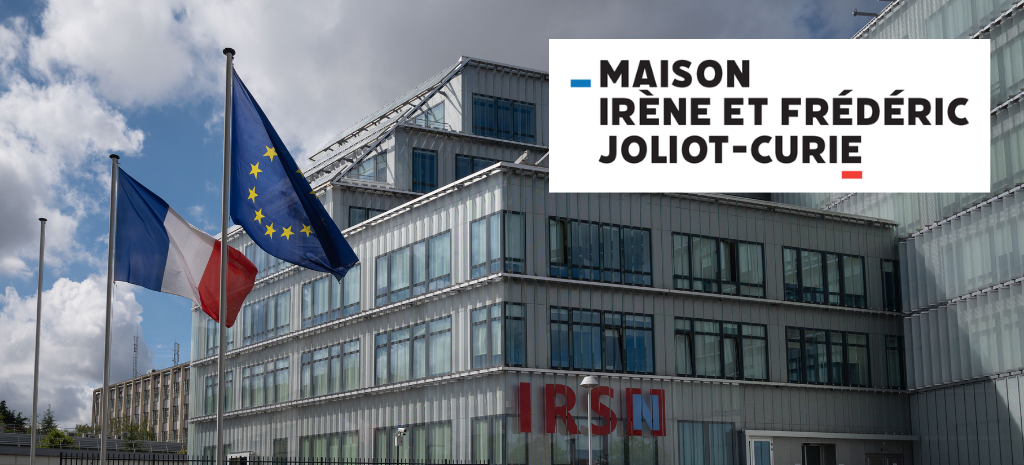
A few days before World Cancer Day, IRSN, in partnership with CEA, INSERM and CNRS, wanted to bring together the main national, European and international stakeholders who contribute to the fight against cancer by using ionizing radiation for diagnostic and therapeutic purposes, such as radiotherapy or the use of radiopharmaceuticals. The essential contribution of these techniques is no longer in question, as shown by the steady increase in the life expectancy of patients.
This day brings together health professionals (radiation oncologists, radiologists, medical physicists), and experts from the academic world as well as representatives from the European Commission or international organizations such as the International Atomic Energy Agency or the World Health Organization.
The presentations and round table discussions will provide an opportunity to exchange ideas on optimizing practices and individualizing treatments in order to better control and anticipate the risks associated with the use of ionizing radiation. These exchanges are all the more important in a context of emerging innovative approaches to diagnosis and treatment, such as the use of artificial intelligence in medicine or massive data processing.
The objective of this event is to identify and discuss the major issues, in terms of research, related to the safe and optimized use of ionizing radiation in the fight against cancer, and to contribute, for all the stakeholders, to a better coordination of the initiatives that are carried out at the French, European and international levels.
IRSN contributes, at national and European level, to the fight against cancer
Technological advances and changes in protocols developments in the fields of imaging, radiotherapy and nuclear medicine are very rapid. Regularly assessing the risks associated with these developments with regard to the therapeutic benefits is at the heart of the missions of the Institute for Radiation Protection and Nuclear Safety. The optimization of practices using ionizing radiation is also a constant objective of the Institute.
To fulfil its missions in these fields, IRSN carries out expert assessments for health authorities and, more generally, for public authorities, and also monitors the exposure of patients, medical personnel and the public.
In support of these assessments and monitoring activities, and in order to be at the forefront of knowledge, the Institute conducts research programs in collaboration with hospital teams and national, European and international partners.
In this sense, since June 2022, IRSN has been coordinating the European PIANOFORTE partnership for research in radiation protection. Part of the work of PIANOFORTE is based on the European priority policy for the fight against cancer, and relies on different European initiatives or projects such as SAMIRA (Strategic Agenda for Medical Ionising Radiation Applications) or Rocc-n-Roll aiming at defining research priorities for medical radiation protection.
At the national level, IRSN's actions are also part of the ten-year cancer control strategy led by INCa. These research activities are focused on optimizing practices, such as the development of modern approaches to dose calculation. The ultimate goal is to personalize treatment and limit side effects in order to improve patients' quality of life after treatment. To contribute to this objective, IRSN has entered into partnerships with hospitals such as Gustave Roussy (project PiRaTT) and AP-HP hospitals (project Epibrainrad and project Radioaide), as well as with academic institutions.
Delegation from the National University of Singapore (NUS)/Singapore Nuclear Research and Safety Initiative (SNRSI) visited IRSN's safety and radiation protection research facilities
A delegation from the National University of Singapore (NUS)/Singapore Nuclear Research and Safety Initiative (SNRSI) led by Professor Pao Chuen LUI, Chairman of SNRSI and SNRSI Director Keng Yeow CHUNG and from the Energy Market Authority led by Director Darryl Kah Inn CHAN visited IRSN's safety and radiation protection research facilities at Cadarache on September 19 and 20, 2022.
The facilities visited were the following:
- AMANDE,
- MIRCOM,
- CABRI model,
- THEMA,
- CHROMIA,
- MAESTRO,
- ODE,
- GALAXIE.
The delegation continued this visit to IRSN Headquarters at Fontenay-aux-Roses on September 23, with a presentation of the research and expertise conducted on atmospheric dispersion models, followed by a presentation of crisis management and the technical Crisis Center.
A final debriefing meeting led by the Director General of IRSN Jean-Christophe NIEL concluded this visit.
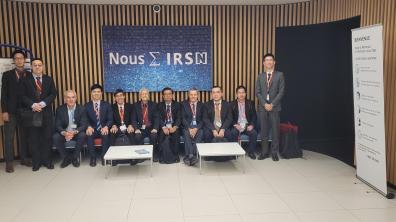
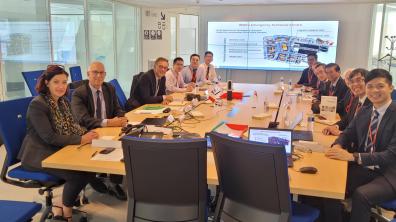
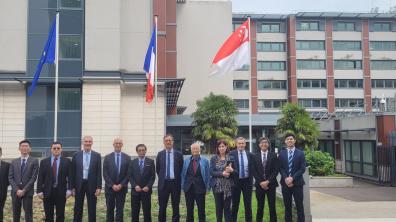
Launch of the "PIANOFORTE" European partnership: research and education for radiation protection
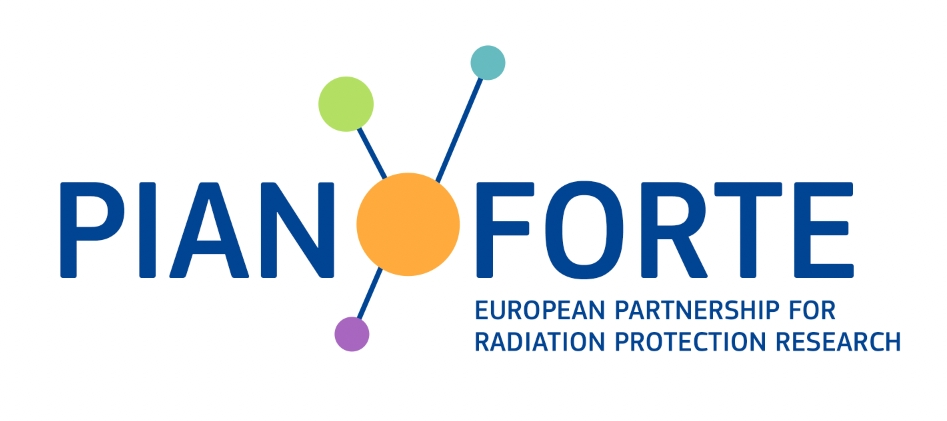
Launched on June 14, 2022 in Paris, the PIANOFORTE research partnership has the ambition to improve knowledge and promote innovation in the field of radiation protection for the benefit of better protection of the public, patients, workers and the environment in all scenarios of exposure to ionizing radiation.
The European Partnership for Radiation Protection Research will contribute to improving the protection of the public, workers, patients and the environment from environmental, occupational and medical exposure to ionizing radiation. It brings together 58 partners representing 22 European Union countries as well as the United Kingdom and Norway, and is coordinated by the French Institute for Radiation Protection and Nuclear Safety (IRSN). It is co-financed by the European Union's EURATOM program and the Member States of the participating countries. Through the research activities that will be carried out within its framework, PIANOFORTE will contribute to the implementation of European policies such as the European plan to combat cancer, the green pact for growth, and the implementation of the roadmap for reducing industrial and natural risks.
Through the scientific challenges it will address, this partnership aims to contribute to priority European policies such as the fight against cancer (European Cancer Action Plan), the protection of health from environmental risks (Green Pact for Growth) and finally the improvement of anticipation and resilience in disaster situations (implementation of the Sendai Framework for Disaster Risk Reduction).
Within this partnership, at least three calls for proposals, open to the entire European research community for radiation protection, will be organized between 2023 and 2025. They will focus on the following four themes:
- improving patient radiation protection in relation to the use of ionizing radiation in the medical field
- a better comprehension of variability of individual response to exposure to ionizing radiation
- the study of mechanisms involved in chronic exposure to low doses of ionizing radiation
- the improvement of anticipation capacities and resilience in nuclear or radiological crisis situations and post-accident management.
Particular attention will be paid to the involvement of all stakeholders (authorities, civil society, radiation protection practitioners, experts, etc.) in the priority setting of the scientific topics that will be the subject of calls for tender and with respect to the question of translating this research into actual impact for strengthened radiation protection. The objective is to meet and integrate the expectations of the wide set of radiation protection stakeholders as best as possible. This partnership also specifically aims to build bridges with research activities carried out at European level in the "non-Euratom" fields, in particular in the health sector.
Beyond these research activities, PIANOFORTE will contribute to maintaining a sustainable capacity of expertise in radiation protection in Europe, which is internationally recognized, in particular by promoting the availability, use and sharing of existing state-of-the-art research infrastructures at the European level as well as by implementing education and training activities.
The partnership will build on previous work, and in particular on the results of the European joint program CONCERT conducted under the H2020 framework program which ended in 2020. It will also benefit from the achievements of other European projects just completed or in progress such as MEDIRAD, HARMONIC, RadoNorm or SINFONIA.
To date, PIANOFORTE involves 58 partners from 22 EU countries as well as the UK and Norway. It mobilizes public partners (public research organizations, authorities in the field of radiation protection, universities) but also the six European research platforms in radiation protection (MELODI, EURADOS, EURAMED, NERIS, ALLIANCE and SHARE). This initial consortium is expected to expand with the entities that will be selected in the framework of the open calls for tenders organized during the partnership.
The partnership will last 5 years and is expected to end in 2027. The estimated budget for PIANOFORTE is 46 million euros, 65% of which will be financed by the European Union and the rest by the partner countries. IRSN is the coordinator of the partnership.
Results of the H2020 Euratom call for projects: a success for IRSN
The European Commission (EC) has just published the results of its call for projects of the Horizon 2020 programme for 2018-2019. IRSN is participating in eight of the thirteen new European projects which will be launched during the year.
The recent success of IRSN's H2020 call for projects is part of the IRSN Contract of operational objectives and performance (COP) renewed with the French State until 2023. One of the challenges of this contract is to develop national, European and international partnership initiatives to deploy the scientific strategy and conduct high-quality research to meet the challenges of expertise. It confirms the IRSN position as a major player in research in the field of nuclear safety, radiation protection and environment. This result reflects IRSN dynamism in the proposals made and its contribution to collective actions for research at European level.
Jean-Christophe Niel, Director general of IRSN, points out that "40% of IRSN budget is dedicated to research to contribute to the improvement of knowledge on nuclear safety and radiation protection and develop the expertise of IRSN with the best scientific knowledge".
For the first time, IRSN was represented in all technical fields. Some of the key research themes selected include:
In the field of nuclear safety: two projects concerning Generation II and III reactors, R2CA (Reduction of Radiological Consequence in design based Assessment), on the radiological consequences of design accidents and their management strategy led by IRSN, and MUSA (Management and Uncertainties in Severe Accidents), on the improvement of severe accident simulation tools, in which IRSN will be in charge of coordinating the Work Package on the study of innovative mitigation means for accidents in storage pool.
In the field of safety of Generation IV reactors: the SAMOSAFER project (Severe Accident Modeling and Safety Assessment for Fluid Fuel Energy Reactors), led by the University of Delft, with IRSN participation.
In the field of safety of light water modular reactors, IRSN takes part in all technical work packages of the ELSMOR project (towards European Licensing of Small MOdular Reactors), led by the Technical Research Center of Finland (VTT).
It should be noted that the Institute will join the continuation of a project on nuclear data for modeling applications: SANDA follow-up (Supplying Accurate Nuclear Data for energy and non-energy Applications), piloted by CIEMAT (Centro de Investigaciones Energéticas Medioambientales y Tecnológicas, Spain). IRSN is also participating in the SHARE project (StakeHolder-based Analysis of REsearch for decommissioning) on the development of a roadmap for research on the decommissioning of facilities.
In the field of nuclear waste management: the EURAD project (EURopean joint programming on RAdioactive Waste Management and Disposal) on all the technical aspects of deep geological disposal of waste, led by ANDRA.
Finally, in the field of radiation protection, the HARMONIC project (Health effect of cArdiac fluoRoscopy and MOderN radiotherapy In pediatriCs), coordinated by ISGlobal Spain, focuses on the health effects of fluoroscopy (or radioscopy) and new approaches to pediatric cardiac radiotherapy.
More information: IRSN research programs
IRSN publishes a study on social consequences of the 3/11 nuclear accident in Fukushima prefecture
Result of the French-Japanese research project Shinrai, the report "The 3/11 accident and its social consequences - Case studies in Fukushima prefecture" analyses post accidental policy in Fukushima prefecture, particularly the questions linked to return or non-return to evacuated towns and villages. The report also compares the concrete experience of the inhabitants and the decision-makers with a number of principles that underlies international post accidental policy and recommendations.
Download IRSN Report 2019/00178: Shinrai research Project: The 3/11 accident and its social consequences. Case studies from Fukushima prefecture
Eight years after the Fukushima Daiichi nuclear accident in Japan, IRSN publishes a report on its social consequences. This research is based on an intensive field work carried out by researchers with inhabitants of the Fukushima prefecture. The Institute investigates this topic within the framework of the Shinrai project, a French-Japanese research program coordinated by IRSN with the participation of Sciences Po Paris and Tokyo Tech.
The framework of this research is inscribed in the field of disaster studies, with a multidisciplinary approach (anthropology, political sciences, sociology) in order to analyze the trust of Japanese citizens towards the government in charge of dealing with the crisis. Between 2014 and 2017, researchers from IRSN and Sciences Po completed 118 interviews during 8 missions of 2 to 3 weeks:
- Inhabitants of the Watari quarter in Fukushima city (60 km from the crippled Fukushima Daiichi nuclear power plant), the town of Naraha and the village of Kawauchi, who were allowed to return or not to their hometown after the lifting of evacuation orders (EOs) by the Japanese government (see interactive map below),
- Government and local representatives to better understand the policy of lifting of EOs after decontamination,
- Non-Profit Organizations (NPOs) or independent experts, who played an important role in informing and supporting the population.
Despite decontamination and the lifting of EOs, the rate of returnees is relatively low. The fieldwork identified six broad categories of inhabitants in relation to their decision to “whether return or not” after the lifting of EOs. This categorization shows the diversity of situations, depending on age, family status - for example, family with children -, commitment to the post accidental policies, confidence in the assessment of radiological situation by government experts.
|
Decision |
Explanations |
|
Return and forget/resist |
They see their return as a relief after a number of relocations and they have no hesitation to come back. This category is primarily composed of seniors settled for several generations in rural areas. They seem to be the least "affected" by the consequences of the accident. They are reluctant to follow the radiation protection advice given by the local authorities because they want to live as much as possible "as before". However, in some families, children and grandchildren have not returned or refuse to visit grandparents. |
|
Return and control/comply |
They return after the lifting of evacuation orders. They comply with advice given on radiation protection by local authorities, and the possibility to measure radioactivity plays a key role for this category of inhabitants. They have an overall confidence in the post accidental policies, including the measures taken by the authorities to reduce ionizing radiation. |
|
Return and worry |
People who return but who have doubts about the radiological situation. They are not sure of having taken "the right decision", which causes great anxiety. The end of the entitlement to statutory monthly compensation payment one year after the lifting of EOs has been felt as a push from the authorities. Another form of pressure is the need to be "loyal" to their hometown. This category is essentially composed of families with young children. |
|
Return and commute |
Some inhabitants come back to work in hometowns while living in the place they were evacuated to. This choice is a source of tension and disagreement with those who have chosen to return "fully". This alternative migratory choice has not been officially recognized by the government or local authority. The government has basically offered only two options to the evacuees after the accident: return with support to restart their lives, or resettle in other places on their own. |
|
Not returning for the moment |
They do not return for the moment, but they plan to come back to their hometown at some point in the future. Their evacuation is presented as a (long) parenthesis. Not returning for the moment can be justified by the need to protect children from contamination. A return later can be linked to a later life project of taking care of elderly parents, who have already resettled. |
|
Not returning ever |
This category of inhabitants does not plan to come back, ever, to Fukushima prefecture. They have, to a certain extent, made a fresh start, and developed in most cases a deep mistrust towards the authorities. Protecting children from radioactivity explains their decision. A choice that is not always shared within families, resulting in many cases of divorces. Non return has sometimes triggered the sense of citizenship, or even political engagement: some become vocal against the post accidental policy led by the government. |
The research highlights the role of local elected representatives, in this case the mayors, by showing how they sought to meet both government requirements and the wishes of their constituents. It also addresses the ethical dilemmas that politicians, authorities and government experts have faced: is it legitimate to reassure the population at all costs? How to decide when the interests of the inhabitants question the notion of "community" conceptualized as a homogeneous set of persons?
The report concludes by comparing concrete situation in Fukushima with a number of principles that underlies international post accidental policy and recommendations. This report identified three ways to fuel the reflections in the French and international bodies in charge of managing the post accidental phase:
- The attachment of the inhabitants to their hometown, observed after the Chernobyl accident, was not verified in Fukushima. However, this is an assumption underlying post accidental policy, as noted in Publication 111 of ICRP, the international body responsible for radioprotection recommendations. The decision of the Japanese government to "reconquer" the territories by entrusting their decontamination to private companies is appreciated by those who wish to return, but denounced by those who would have preferred that the money be invested otherwise (allowing a final relocation for example).
- The commensurability of radiological risk with other risks (tobacco, alcohol or natural risks specific to Japan). This rationale is recurrent in the discourses of radiological protection but shows some limitations in the aftermath of the Fukushima nuclear accident. While this principle is acceptable to some inhabitants, it is radically dismissed by others, who cannot put in balance the health of their children or accept this “balanced” approach.
- The designation of zones as a tool for radiation protection of populations. This pillar of Japanese post accidental policy was based on the international regulation and recommendation framework established by ICRP and IAEA. However, zoning choices have been questioned, including their definition based on the level of radioactivity measured or estimated for the future.
Download IRSN Report 2019/00178: Shinrai research Project: The 3/11 accident and its social consequences. Case studies from Fukushima prefecture
About the Shinrai project
Shinrai ("confidence", in Japanese) is a French-Japanese research project started in 2014. Led by IRSN with the participation of Sciences Po Paris and Tokyo Tech, it aims to investigate the decision making methods used by authorities following the accident and their impact on the population.
The project studies the role of public authorities, their trustworthiness (ability to meet the confidence of citizens) and their accountability (ability to account to their own decisions), including in a context when scientific data alone do not allow to proceed and legitimize decisions.
